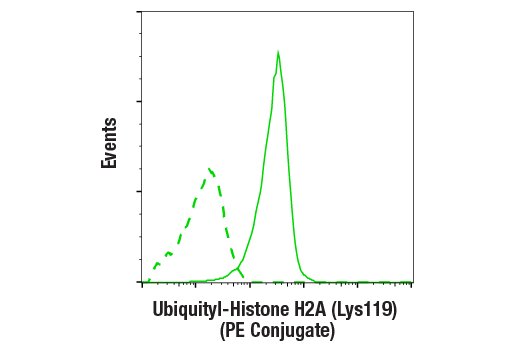The nucleosome, made up of four core histone proteins (H2A, H2B, H3, and H4), is the primary building block of chromatin. Originally thought to function as a static scaffold for DNA packaging, histones have now been shown to be dynamic proteins, undergoing multiple types of posttranslational modifications, including acetylation, phosphorylation, methylation, and ubiquitination (1). Ubiquitin is a conserved 76 amino acid peptide unit that can be covalently linked to many cellular proteins by the ubiquitination process. Three components are involved in this protein-ubiquitin conjugation process. Ubiquitin is first activated by forming a thioester complex with the activation component E1; the activated ubiquitin is subsequently transferred to the ubiquitin-carrier protein E2, then from E2 to ubiquitin ligase E3 for final delivery to the epsilon-NH2 of the target protein lysine residue (2). Histone H2A is mono-ubiquitinated at Lys119 by the Polycomb Repressor Complex 1 (PRC1) and is critical for transcriptional silencing of the developmental HOX genes and X chromosome inactivation (3-6). PRC1 is composed of Bmi1 and RING1A (also RING1 or RNF1), both of which act to enhance the E3 ubiquitin ligase activity of the catalytic subunit RING1B (also RING2 or RNF2) (3,4). Histone H2A is also mono-ubiquitinated at Lys119 at sites of DNA damage. This mono-ubiquitination event requires the PRC1 components Bmi1 and RING1B, in addition to another E3 ubiquitin ligase RNF8, and contributes to subsequent recruitment of the BRCA1 complex, via binding of RAP80/UIMC1 (ubiquitin interactive motif containing 1 protein) (7-10).
1.Peterson, C.L. and Laniel, M.A. (2004) Curr Biol 14, R546-51.
2.Liu, F. and Walters, K.J. (2010) Trends Biochem Sci 35, 352-60.
3.Wang, H. et al. (2004) Nature 431, 873-8.
4.Cao, R. et al. (2005) Mol Cell 20, 845-54.
5.de Napoles, M. et al. (2004) Dev Cell 7, 663-76.
6.Fang, J. et al. (2004) J Biol Chem 279, 52812-5.
7.Ginjala, V. et al. (2011) Mol Cell Biol 31, 1972-82.
8.Bergink, S. et al. (2006) Genes Dev 20, 1343-52.
9.Marteijn, J.A. et al. (2009) J Cell Biol 186, 835-47.
10.Wu, J. et al. (2009) Mol Cell Biol 29, 849-60.
 全部商品分类
全部商品分类























 用小程序,查商品更便捷
用小程序,查商品更便捷




